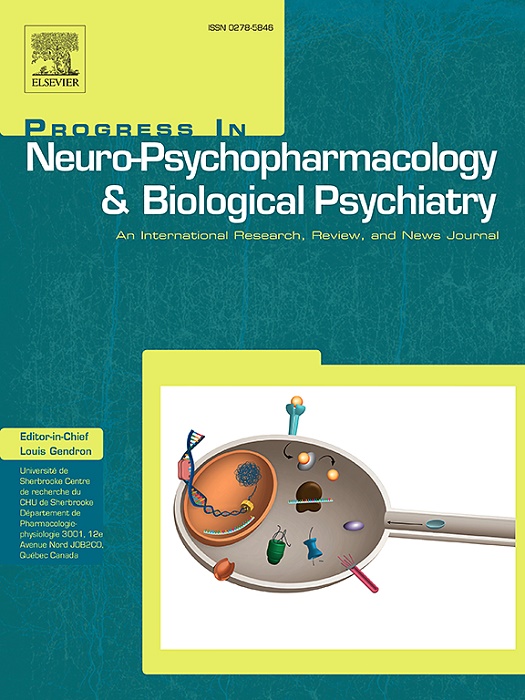Integrating gene expression, neurochemical signatures, and neurocognitive profiles to decode cortical reorganization in IBS-D
IF 3.9
2区 医学
Q1 CLINICAL NEUROLOGY
Progress in Neuro-Psychopharmacology & Biological Psychiatry
Pub Date : 2025-08-22
DOI:10.1016/j.pnpbp.2025.111474
引用次数: 0
Abstract
Irritable bowel syndrome with diarrhea (IBS-D) is characterized by persistent gastrointestinal symptoms and marked alterations in brain structure. This study aimed to explore the neurobiological mechanisms that may link these structural changes to the disorder. We investigated hierarchical cortical organization in 31 IBS-D patients and 35 healthy controls (HCs) using morphometric similarity (MS) gradients derived from structural MRI features. Imaging-correspondence analyses were used to decode IBS-D related MS gradient changes with gene expression, neurotransmitter systems, and cognitive functions. Compared to HCs, IBS-D patients exhibited reduced MS gradients in limbic and temporal regions (e.g., entorhinal cortex, superior temporal gyrus) and elevated gradients in fronto-parietal areas (e.g., precuneus, rostral middle frontal cortex). These gradient alterations were spatially correlated with genes enriched for immune response pathways and neurotransmitter systems, including dopamine D2, serotonin 5-HT1a/1b, and GABAa receptors (adjusted R2 = 0.38, pspin = 0.046). Furthermore, gradient shifts overlapped with brain activation patterns linked to emotional regulation (e.g., valence, arousal) and attentional processes (pFDR < 0.05). Our findings reveal that cortico-limbic gradient reorganization in IBS-D reflects interactions among immune-related genetic pathways and neurotransmitter dysregulation, providing novel targets for interventions addressing brain-gut axis disruptions.
整合基因表达、神经化学特征和神经认知谱来解码IBS-D的皮层重组
肠易激综合征伴腹泻(IBS-D)的特点是持续的胃肠道症状和显著的脑结构改变。本研究旨在探索可能将这些结构变化与该疾病联系起来的神经生物学机制。我们使用源自结构MRI特征的形态相似性梯度(MS)研究了31名IBS-D患者和35名健康对照(hc)的皮层分层组织。成像对应分析用于解码IBS-D相关的MS梯度变化与基因表达,神经递质系统和认知功能。与hc相比,IBS-D患者表现出边缘和颞叶区域(如内鼻皮层、颞上回)的MS梯度降低,额顶叶区域(如楔前叶、吻侧额叶中皮层)的MS梯度升高。这些梯度变化在空间上与免疫反应途径和神经递质系统富集的基因相关,包括多巴胺D2、血清素5-HT1a/1b和GABAa受体(调整后R2 = 0.38, pspin = 0.046)。此外,梯度转移与与情绪调节(如效价、觉醒)和注意力过程相关的大脑激活模式重叠(pFDR < 0.05)。我们的研究结果表明,IBS-D中的皮质边缘梯度重组反映了免疫相关遗传途径和神经递质失调之间的相互作用,为解决脑肠轴中断的干预提供了新的靶点。
本文章由计算机程序翻译,如有差异,请以英文原文为准。
求助全文
约1分钟内获得全文
求助全文
来源期刊
CiteScore
12.00
自引率
1.80%
发文量
153
审稿时长
56 days
期刊介绍:
Progress in Neuro-Psychopharmacology & Biological Psychiatry is an international and multidisciplinary journal which aims to ensure the rapid publication of authoritative reviews and research papers dealing with experimental and clinical aspects of neuro-psychopharmacology and biological psychiatry. Issues of the journal are regularly devoted wholly in or in part to a topical subject.
Progress in Neuro-Psychopharmacology & Biological Psychiatry does not publish work on the actions of biological extracts unless the pharmacological active molecular substrate and/or specific receptor binding properties of the extract compounds are elucidated.

 求助内容:
求助内容: 应助结果提醒方式:
应助结果提醒方式:


